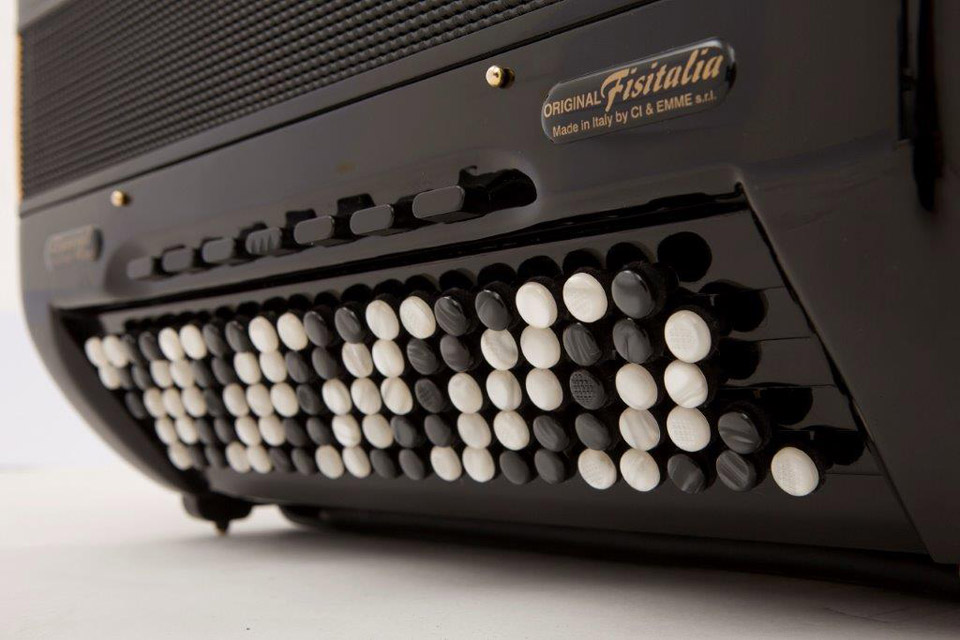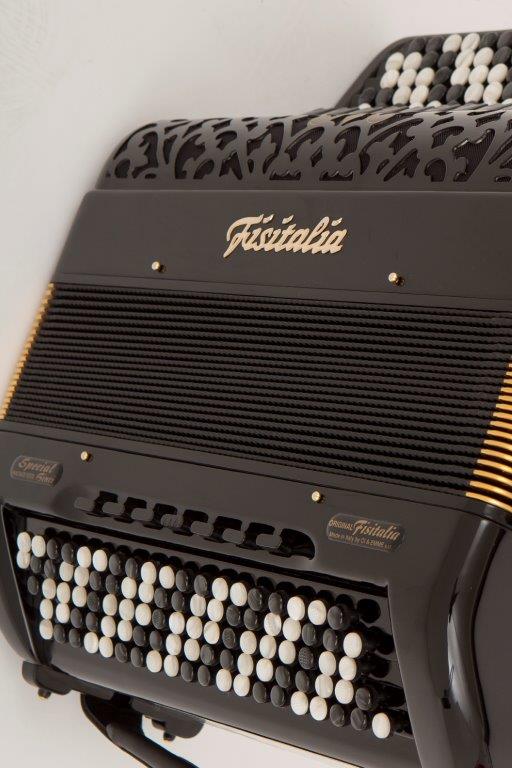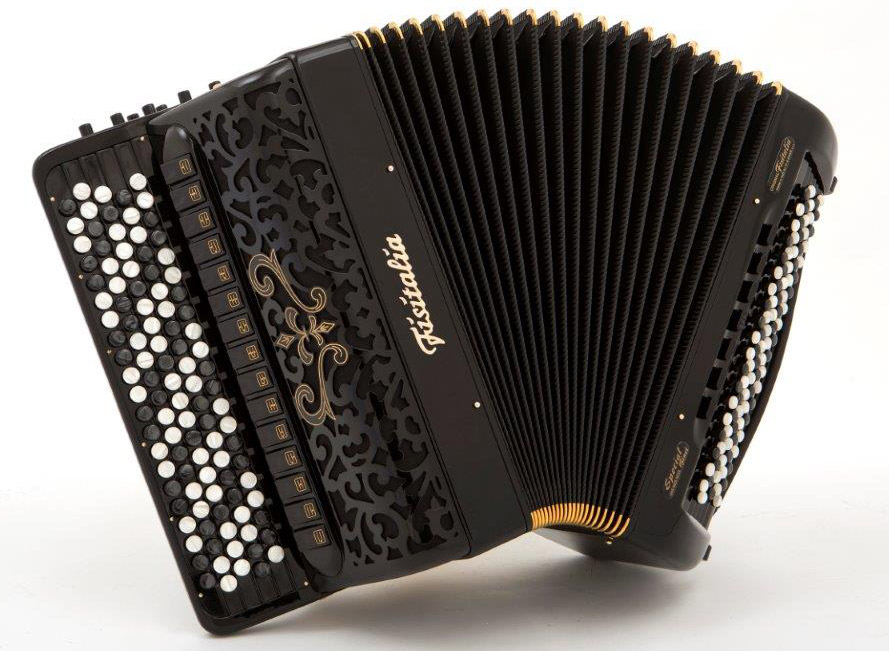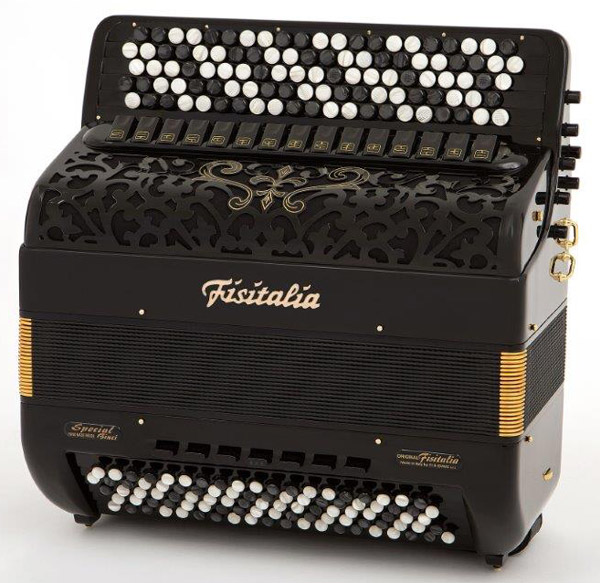Fisitalia Press Release: June 2017 Fisitalia "Bayan-Ergo"
|

Due to further development of the Stradella bass (pure standard bass accordion in the 70s) adding the converter model, the accordion gained a significant boost for artistic playing. More and more compositions were created for the improved accordion with several octaves of bass. In the meantime, the teaching/playing of the convertor accordion is a prerequisite for a successful study at a music colleges. By the 1980s, some tutors tried to create further distance from the standard bass mechanics and to develop the pure Melodiebass (free bass) accordion. But the feeling of the bass was not the same as the treble, as the bass note-board was not intended for single-note playing with the thumb, with the bass note-board being initially designed for standard bass. The accordionists stayed with the converter model.  The advantages of the BAYAN-ERGO are based on its detail: The clearly slanted bass side and the larger bass buttons allow the player to have better and more natural hand and finger position, thus facilitating easier performance. Due to this structural change, the thumb can also be used, and it is possible to apply the same way of playing for the left hand as for the right hand. Some players are already using a conventional converter model, but have to "force" the thumb into an unnatural attitude. In this way, chronic reorientations of the thumb base and thumb saddle joint are virtually preprogrammed, especially for beginners. In case of a long lasting rehearsal or practice, this might lead to premature joint wear and stress, which can often be felt only after many years. Such problems can be prevented by an ergonomically revised accordion. Apart from this, there are also clear advantages in terms of playing technique: 1) Easier and freer hand movement and glissandi are possible; Other technical advantages of the BAYAN-ERGO compared to a normal converter model are, without a doubt, the no quieter bass mechanism. Fisitalia and Fisitalia-Germany have now decided to launch an "Ergonomic Line" series (abbreviated as: ERGO) and to create another button model of medium size so that younger/smaller students can learn this new ergonomic system. It is not yet definitely decided, which accordion models are included in this new line. This development for an accordion construction is not really a new idea, as Giovanni Gagliardi (1882-1964), an Italian accordionist and composer from Castelvetro Piacentino (region: Emilia-Romagna), already had the idea of a pure single-tone accordion in 1910. Unfortunately, the time for single-tone music was not yet entirely studied and his dream therefore was soon forgotten. Even in the 1980s, the single-tone playing was not as pronounced as it is today, so that the production with that particular bass system never continued. We believe, that anybody who would like to develop further should always be openly minded towards new ideas, especially if the final goal is not yet reached for "habit makes mistakes acceptable, which we have lived since our youth," as the German poet Christian Fürchtegott Gellert writes in his poem from the year 1769. Moreover, these new models would simply have had more time to “be”, as was the case with the development of the single-tone literature. A model from our "Ergonomic-Line" series has a lot more advantages than disadvantages of the demanding single-tone player, which will change / improve the way of playing and give composers further technical possibilities. The BAYAN-ERGO model gives a voluminous sound with an optimal response and a new range of notes, which extends to the Contra-C. A video documenting the benefits of this instrument will soon be available on the Fisitalia website (see below for contact details). Of course, every technical change for the accordionist means that he/she has to get used to the new system. But with a bit of practice, this ERGO system is very useable and the standard bass chords will soon no longer be missed. Previously, a button accordion in the treble was also played with only four fingers. Meanwhile, the necessity of the thumb has been recognized. Why should one not use all ten fingers – if we have them? For standard bass literature, playing without a thumb is perfectly adequate and the pitch of the bass grip board fits exactly. However, if the thumb is also used for the relevant literature, an ergonomic model is the only and correct instrument. For a pianist, it is a matter of course to extract the chords with the left hand, and it can also play entertainment music. That's why we see no reason to insist on the standard bass if its rarely used anyway, or the performer is focused on single-tone compositions only. |

|
Site
constructed and hosted by: Accordions Worldwide at www.accordions.com.
© Copyright 2017 Accordions Worldwide. All rights reserved |
